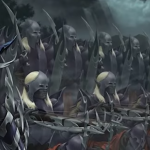Harnessing the invisible currents of power that sweep across the realms, wind-based spells in Dungeons & Dragons offer a breathtaking array of magical prowess.
From summoning storms to flying through the sky, these air spells allow the players to wield the winds as a mighty weapon. In this article, we delve into the realm of the arcane winds, exploring the 10 best wind spells in D&D:
1. Gust
The simplest air spell in this list, Gust is a cantrip that creates a small gust of wind to push creatures and objects around. As it is a cantrip, it does not possess much power, but it can offer some utility in and out of combat. The cantrip can push a creature 5 feet away from you to either give you some space to escape or push it into a trap or hole.
It can also be used to move small objects around or create some sounds like leaves rustling or some clothes rippling. Gust is not a powerful cantrip, but being a cantrip and providing utility makes it quite a decent tool for many spellcasters.
2. Warding Wind
With this spell, you manipulate the wind and air around you to form a barrier resembling a tornado. While this qir spell is mainly used to your benefit, the loud sounds of wind blowing near your ears cause you to be deafened, but in exchange, you extinguish flames and remove gases and fog within the area.
Due to the strong winds, projectile attacks from weapons such as bows and slings have disadvantage against you. This spell seemingly provides a lot of benefits to the user, but most of them are situational, aside from defending against ranged attacks.
Since the spell can only be cast on the caster, it finds more use on characters who tend to be at the front of combat, targeted by ranged attackers while in the midst of fire and smoke.

3. Dust Devil
This 2nd-level wid spell, much like the name suggests, creates a dust devil. The spell requires concentration and lasts for one minute, but you can still move the devil around to cause more chaos.
The dust devil itself takes up one 5-foot cube, and any creatures that end their turn adjacent to it must make a saving throw or take bludgeoning damage and be pushed back. The spell deals some damage, but its main use is zoning; to stop creatures from reaching your allies or certain objectives.
Its use is not only that creatures are pushed back from it, but its existence will also deter most creatures, and the few that have the resolve to push through it will just take damage. The spell can often be misused, but once its purpose is understood, it offers good potential defense to the whole party.
4. Feather Fall
A very common air spell used by any caster that can use it, Feather Fall finds a place in all parties and for good reason. Firstly, it is a 1st-level spell, and it is accessible to wizards, sorcerers, and bards, all spellcasters that possess a great number of spell slots and spells and tend to be at the back where they have a viewpoint of every member of the party.
Feather Fall can be cast on up to 5 falling creatures, including the caster; once the spell is cast, the creatures take no fall damage if they land before the spell ends. A very simple spell but amazingly useful. Most players can recall a time when they fell and almost lost their characters or needed to traverse a great height, but their hit points held them back.
Feather Fall can help in any situation that includes falling, be it falling from a skyship because you were pushed off or jumping down a wizard tower to catch the fleeing BBEG. An amazing spell that should be in every party’s arsenal.
5. Control Weather
This 8th-level spell allows the manipulation of the weather. To cast Control Weather, you must first be able to identify the current weather and have clear access to it. Once that has been done, you can change three aspects of the weather: its precipitation, its temperature, and its wind.
You can only change these conditions based on tables given in the spell description, and you can only change it slightly, making it slightly warmer, colder, etc. Not being able to freely manipulate the weather with an 8th-level spell does decrease its effectiveness, but even then, the spell can be a true show of power, even if its benefits are not too great.

6. Gust of Wind
This 2nd-level spell can be used to create a strong wind that originates from the caster and can reach up to 60 feet away in a chosen direction. Any creatures that start their turn on the line must make a saving throw or are pushed back 15 feet, and walking against the wind counts as difficult terrain. The spell can also be used to extinguish flames and remove gases in the area.
Using a bonus action on subsequent turns, the spell can be redirected. This spell might seem lackluster for a 2nd-level spell, but it has so much potential. Similar to Gust, it can be used to push creatures into traps and holes or away from you and your allies; with its 15-foot push, it allows for greater danger against those who face it. Another unseen use is its ability to launch creatures and objects or enhance their speed. A creature running along with the wind can be propelled faster (with the DM’s discretion) to reach its target faster.
And since Gust of Wind can be redirected, it can be used to keep pushing a single target back over and over, giving your team some space and time to either escape or make a move. Both a fun and powerful spell, Gust of Wind can offer many uses to enjoyers of the elements.
7. Wind Walk
The name of the spell is a bit misleading; Wind Walk is a 6th-level spell that can target up to 11 creatures, including the caster, and transform them into a cloud form. While the creatures are transformed, they gain a massive flying speed of 300 feet. It also lasts 8 hours.
A simple air spell on paper but with amazing potential. Wind walk is a great substitute for vehicles as it costs nothing apart from a spell slot to cast and allows you to travel vast distances at great speeds.
Wind Walk grants a flying speed which is useful everywhere except underwater, and most adventures do not spend much time underwater, leaving a lot of use to every campaign.
8. Wind Wall
Using Wind Wall, you can create a wall of wind 15 feet tall and up to 50 feet long, effectively covering thirty squares on a battle map. You choose the shape the wall takes, but it must be continuous. Any creature that is along the wall while it’s being created makes a saving throw or takes bludgeoning damage.
Aside from its initial casting, the spell remains for one minute, during which any small creatures and objects are thrown upwards by the force of the wind, including any projectiles targeted at the caster.
It also removes fog and gases from the area it is on, and any gaseous creatures cannot pass through it. This spell is similar in many ways to the Warding Wind spell but improved since it can act as a surefire way to avoid projectiles and knock opponents away and keep them away.
9. Control Winds
Control Winds allows the caster to manipulate the flow of the wind inside a 100-foot cube. Within this cube, you can change the wind in three different ways: updraft, downdraft, or gusts. By changing it to updraft, you slow the falling rate and increase the jumping height of creatures.
Changing it to downdraft makes flying creatures potentially fall down, and ranged attacks through it are made with disadvantage. The last type of wind, gusts, makes the area count as difficult terrain, while making ranged attacks gain disadvantage. Control Winds covers a very large area and offers multiple different effects for different situations.
Downdraft and gusts are better used for combat, with downdraft pulling down annoying flying enemies, while gusts slow everyone down and weaken ranged attacks. Updraft, though, has multiple uses. It can be used to reach unreachable heights or, similar to Feather Fall, to slow the fall.
10. Whirlwind
With such a simple name, you would assume that this 7th-level wind spell would be quite simple, and it is. The spell creates a whirlwind that is 30 feet tall and covers a 10-foot radius; the whirlwind sucks up medium and smaller objects that aren’t bolted down. Creatures must make a saving throw or be pulled into it and take 10d6 bludgeoning damage. If the creature is large or smaller, it is fully lifted off the ground. Every turn, the creature is lifted further up into the whirlwind, and it can remake the saving throw to escape.
If a creature manages to escape, it is thrown away in a random direction. The spell is mainly used for combat and doesn’t provide much utility outside, aside from helping you move objects out of your way perhaps.
In combat, Whirlwind can be a force to be reckoned with, with its very high damage and ability to disperse enemies, breaking their ranks while also immobilizing a fair few of them as well. A fun wind spell that really encompasses the powers of the wind and air while being very powerful.
